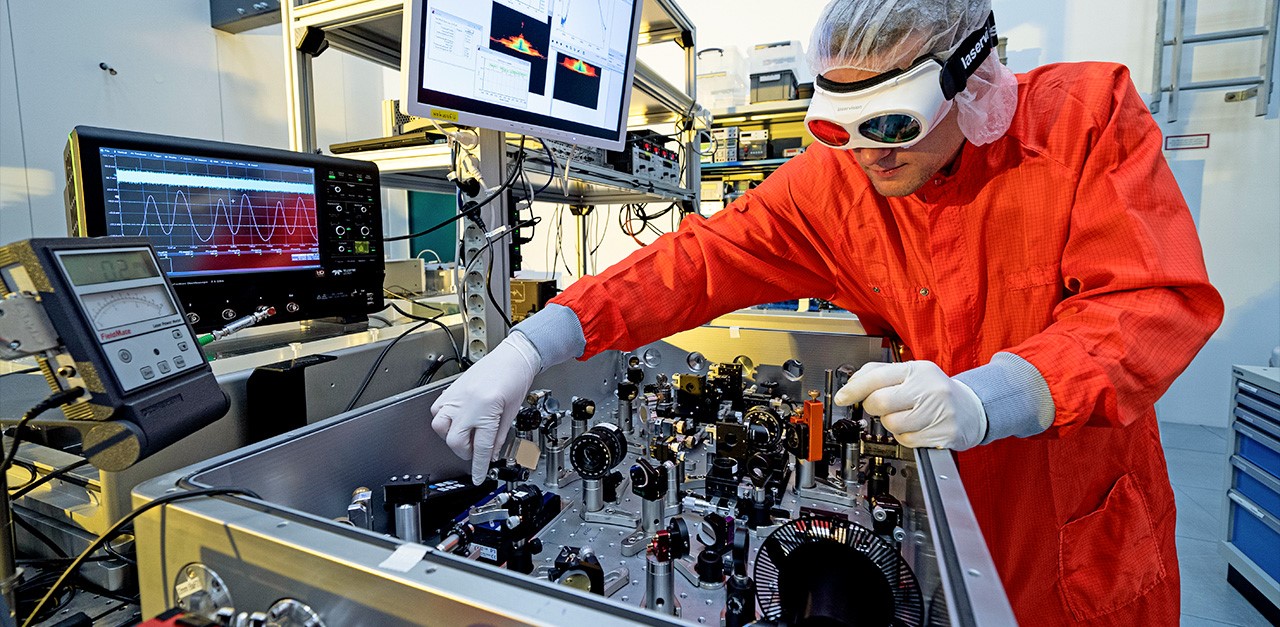InfraLight
Broadband mid-infrared lasers sources with high repetition rate in combination with field-resolved detection, so called infrasamplers, are developed for medical applications of vibrational spectroscopy.
Infrasamplers, 1st Generation
Our different infrared field-resolved molecular fingerprinting instruments (Infrasamplers) use ultrashort mid-infrared pulses to excite molecular vibrations in human blood samples. Then, electro-optic sampling records the response directly on the electric-field level. The measured signal reports on the complex molecular composition of the blood sample. The combination of latest ultrafast laser technology with ultra-sensitive field-resolved metrology allows to access unprecedented levels of sensitivity and opens the prospect to detect minuscule changes in human-blood composition and enable a new type of infrared-based early disease detection. The first-generation Infrasamplers are based on high-power, Kerr-lens modelocked Yb:YAG thin-disk oscillators. The output pulses are post-compressed in Herriott-type multi-pass stages to pulse durations of 10-20 fs pulse. Intra-pulse difference frequency generation yields few-cycle mid-infrared pulses, used to excite the samples. The field-resolved detection with electro-optic sampling employs a synchronized dual-oscillator approach with down to sub-attosecond calibration of the delay axis to perform highly reproducible scans of the infrared waveforms at multi-kHz rates. The instruments are equipped with automated sample-exchange units for large-scale human blood sample studies.

Infrasamplers, 3rd Generation
The new-generation Infrasampler devices are based on Cr:ZnS laser technology. Output center wavelengths between 2 and 3 μm make ultrashort Cr:ZnS oscillators ideal sources for efficient and broadband mid-infrared generation by down-conversion. In our systems, the direct output of the oscillators is post-compressed in a bulk medium to single-cycle duration. Combining direct diode pumping of the oscillators with active carrier-envelope-phase (CEP) stabilization ensures highest reproducibility for the single-cycle waveforms. Cascaded intra-pulse difference frequency generation yields a supercontinuum spanning 3.7 octaves, from < 1 μm to > 12 μm, with CEP-controllable mid-infrared waveforms. The large mid-infrared spectral coverage and low-noise performance provides optimum conditions for field-resolved infrared molecular fingerprinting. As in the first-generation instruments, the mid-infrared pulses excite molecular vibrations in a liquid sample. Field-resolved detection with electro-optic sampling records the molecular response as a fingerprint signal, which is sensitive to the complex sample composition. The unique parameters of the system in terms of bandwidth and noise performance maximize the information content that can be extracted from the response signals. Infrasampler 3 will be used for large-scale human blood sample studies following our vision to use the potential of infrared molecular fingerprinting for early disease detection.
The infrasampler technology is utilised by the Broadband Infrared Diagnostics (BIRD) team to develop novel biomedical application. The infrasampler 1.x technology is used to establish in-vitro diagnostic test on human blood plasma and other biofluids for the early detection of cancer. The expanded performance of infrasampler 3.x is expected to provide further improvements for disease detection and opens the possibility towards health monitoring.

